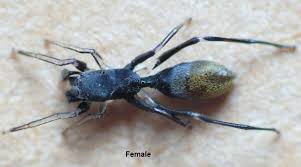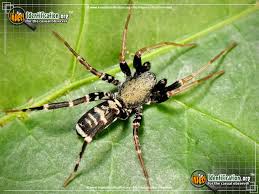
SPIDERS
Arkansas Spiders
Ant Mimic Spider
Female

Male

This strikingly patterned species is a wandering hunter, often catching prey at night as well as during the day. They live close to the ground, under rocks and logs or in leaf litter, but are also occasionally found on (or in) buildings. Their movements are often ant-like, earning them the nickname “antmimic.”
Arrow Shaped Micrathena
Female

Male

The “Arrow Shaped Micrathena” is a unique little Orb Weaver found in the eastern U.S. west to Nebraska and Texas. The shape and coloration of the female make it easily identifiable. The orb web of this species is usually built in low bushes in open deciduous woodlands and along forest edges.
Barn Funnel Weaver
Female

Male

Today, this species occurs nearly everywhere people live, having spread with international commerce. The sheet-like webs of this spider are conspicuous in dark corners of barns, cellars, sheds, garages, cabins, and other man-made structures. Adult males frequently get caught in bathtubs or sinks at night.
Banded Garden Spider
Female

Male

Females are large, silvery spiders with legs banded in black and yellow. Look for this species in late summer and fall in fields, prairies, gardens, and meadows. The circular webs are built close to the ground amid tall grasses and weeds, often with a zigzag band of silk running through the center.
Black and Yellow Garden Spider
Female

Male

Mature females are enormous, their bold black-and-yellow pattern adding to their intimidating appearance. Common in gardens, orchards, forest edges, old fields, and farms, they spin a classic round orb web which is usually decorated with a bold, zigzag band of silk called a stabilimentum.
Broad-faced Sac Spider
Female

Male

This species is a wandering hunter that may be encountered indoors on occasion and is often referred to as the “Broad-faced Sac Spider.” Normally lives in leaf litter, under bark, or in curled leaves, where it hides by day and emerges at night to prowl for insects. Often confused with the “Woodlouse Hunter,” but lacks the long jaws of that species.
Bold Jumper
Female

Male

The “Bold Jumper” is one of the largest and most common species of jumping spider in North America. The spider is mostly black with a conspicuous white, orange, or red triangular patch in the center of its abdomen. Take a close look at this spider’s chelicerae (jaws), as they have a gorgeous, iridescent sheen to them and come in a variety of colors!
Brown Recluse
Female

Male

The “Brown Recluse” is one of the few species in North America whose venom is considered medically significant. It is very timid and non-aggressive and simple precautions can be taken to avoid bites. The eye arrangement is an important diagnostic feature.
Brown Widow Spider
Female

Male

The “Brown Widow” is probably native to Africa, but now found almost globally in subtropical regions. Its affinity for man-made structures has allowed it to spread via commerce. It can be common in yards and gardens, often in more exposed situations than other widow species. The spiky egg sacs are fairly diagnostic.
Carolina Wolf Spider
Female

Male

This species is the largest “wolf spider” in North America. Females reach 22-35 millimeters in body length. Their legs pan is greater still. This spider may hunt actively at night, or wait in ambush at the mouth of its burrow, where it hides during the day. Adult males may wander indoors during mating season.
Common House Spider
Female

Male

This species is abundant and widespread across the entire world, and is closely associated with buildings and other man-made structures. The teardrop-shaped, papery brown egg sacs can aid in their identification. The spider’s color and body shape cause them to be mistaken for “brown widows” on occasion.
Dark Fishing Spider
Female

Male

These very large, sprawling arachnids are most often found on vertical surfaces: tree trunks, fence posts, bridge pilings, or the exterior walls of buildings, usually at night. There, they wait in ambush for large insects to come within striking distance. They do not spin webs to catch prey, but simply overpower their victims.
Green Lynx Spider
Female

Male

This is a relatively large, bright green spider with long, spiny legs and lightning fast movements. They are typically spotted in shrubs and bushes during the day, where they are sit-and-wait predators. Incredibly, this spider is capable of “spitting” venom in self-defense.
Goldenrod Crab Spider
Female

Male

This spider is an ambush hunter, lying patiently in wait on flowers for an insect to come within striking range. Adult females may be overall yellow or white, with the ability to change back and forth. This species can conquer surprisingly large prey like bees and butterflies.
Grass Spiders
Female

Male

“Grass Spiders” are represented by 13 species collectively found throughout most of the U.S. and southern Canada, and northern Mexico. Like all members of the funnel weaver family Agelenidae, they spin dense, non-sticky, sheet-like webs with a funnel-like retreat where the spider
Eastern Parson Spider
Female

Male

This is a hunting spider that does not spin a web to capture prey. It gets its common name from the black and white color pattern reminiscent of the garb worn by old-time clergymen. Common east of the Rocky Mountains, it sometimes strays indoors in the course of prowling for a meal or seeking a mate.
Gray Wall Jumper
Female

Male

This species is native to the Old World tropics, but has ridden cargo to many other tropical and subtropical places around the globe. Look for these jumping spiders almost exclusively on the exterior walls of buildings here in the U.S. They are active hunters during the day and spend the night hidden away in crevices.
Long Bodied Cellar Spider
Female

Male

The Long Bodied Cellar Spider is thought to be native to Europe, but can be found globally after having traveled nearly everywhere as a stowaway in commerce. Their long, thin legs and elongated abdomen make them relatively easy to identify. Find them on ceilings, in basements, storage sheds, old wells, caves, and other dry locations with low light.
Long-legged Sac Spider
Female

Male

“Long-legged Sac Spiders” are pale green, tan, or yellow nocturnal hunting spiders with very long front legs. Native to southern Europe, this spider has made its way into North America, where it is now fairly widespread. It is commonly found indoors, where it prowls walls and ceilings at night, looking for prey or mates.
Nursery Web Spider
Female

Male

This is a large hunting spider that comes in a variety of color forms, sometimes making them more difficult to identify. It is a commonly seen species throughout the eastern United States and southeastern Canada. Females construct a nursery web and suspend their egg sac in it, guarding the babies that emerge.
Orchard Orb Weaver
Female

Male

“Orchard Orb Weavers” are brilliantly colored spiders with shimmering silver-white, green, and gold on their abdomens. The orb-shaped web is nearly horizontal and the spider hangs underneath it. It is a common and widespread species in eastern North America, as well as parts of California and Arizona.
Six-spotted Fishing Spider
Female

Male

A large and strong hunting spider, this species is more closely associated with water than any of the other Nearctic fishing spiders. Find it among aquatic vegetation at the margins of streams and rivers, as well as floating around in lakes and residential pools. It eats aquatic insects, small fish, or even small amphibians!
Southern Black Widow
Female

Male

Mature females are black with a red hourglass on the belly, easily visible as the spider hangs upside down in its web at night. By day, they hide. Immature females have pale stripes and spots, gradually losing those markings as they age. These are shy spiders, and if you avoid placing your hands where you can’t see, bites are unlikely.
Southern House Spider
Female

Male

This species is often associated with human habitations, spreading its web from cracks and crevices on the exterior of homes, barns, and other structures. Males are frequently mistaken for recluse spiders (genus Loxosceles). The females may live up to eight years.
Spitting Spider
Female

Male

This ornately-marked spider immobilizes its prey by spitting a mixture of silk, glue, and venom onto it. Watch for this slow-moving species leisurely walking the walls and ceilings at night. They are easily recognized by their dome-shaped carapace and thin, banded legs.
Spotted Orb Weaver
Female

Male

This ornately-marked spider immobilizes its prey by spitting a mixture of silk, glue, and venom onto it. Watch for this slow-moving species leisurely walking the walls and ceilings at night. They are easily recognized by their dome-shaped carapace and thin, banded legs.
Tan Jumping Spider
Female

Male

These jumping spiders are frequently seen patrolling the outer walls of buildings and other vertical surfaces, looking for bugs to pounce on. The mottled gray, black, and white scalloped pattern on their abdomen makes them one of the easier spiders to identify in the field.
Whitebanded Crab Spider
Female

Male

This spider waits in ambush on flowers for visiting insects to come within range, seizing a victim in the embrace of its first two pairs of legs. Adult females can change from white to yellow and vice versa, though the change takes some time. Males are very small and strikingly different than females.
Woodlouse Hunter
Female

Male

Native to Europe, and now widespread across the globe, this brightly colored spider is hard to miss. The long jaws and fangs are used to stab or turn over its prey: land isopods like sowbugs and roly-polies. This species does not spin a web, but hunts “on foot,” sometimes straying indoors.
Zebra Jumper
Female

Male

The zebra-like color pattern makes this species one of the easier jumping spiders to identify in the field. It is most common around urban and suburban areas where it hunts by day on fences, rock walls, the exterior of buildings, and similar situations. Thought to be native to Europe, it is also now established in the U.S., southern Canada, and Asia.
 Little Rock, AR 501-868-3837 | Russellville, AR 479-968-4777 | Hot Springs, AR 501-442-5653 | Fayetteville, AR 479-899-6874
Little Rock, AR 501-868-3837 | Russellville, AR 479-968-4777 | Hot Springs, AR 501-442-5653 | Fayetteville, AR 479-899-6874





































